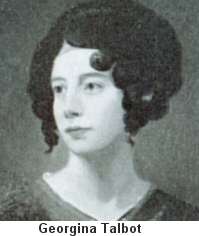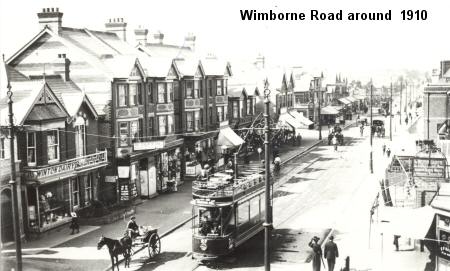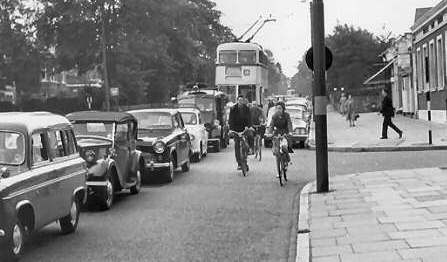|
Winton - product of Victorian vision
The building of Winton
Like Bournemouth, the Winton we know today is a
relatively young settlement. It dates back around one hundred
and fifty years and was partly constructed over clay and gravel
pits. The local white clay was used to make bricks. You can still
see it in some of the older cottages. Some of the claypits and
kilns were located on Shorthorn and Claypit Commons - areas now
rougly bounded by Alma and Acland Roads.
 Key
figures in the area's development were the landowning sisters
Georgina and Marianne Talbot. Good examples of the Victorian moral
conscience, heir name lives on in place and
street names. Key
figures in the area's development were the landowning sisters
Georgina and Marianne Talbot. Good examples of the Victorian moral
conscience, heir name lives on in place and
street names.
Landed and wealthy, they were moved by the desperate
plight of poverty-stricken local agricultural workers and their
families, and determined to do what they could to give them a
better life.
Around 1850 they set about the development of Talbot
Village as a model of working class accommodation. Looking a short
distance to the East, they also purchased land along the edge
of what is now Wimborne Road. On it they sank wells and constructed
cottages. This was to become the original Winton.
The name Winton is thought to have been chosen to
reflect their Scottish ancestry and connections - and specifically
the Earl of Winton. whose Scottish
Winton estate is on the banks of the River Tyne about fifteen
miles east of Edinburgh. The Scottish influence was continued
by the Earl of Leven and Melville who inherited land from the
Talbot sisters and developed West and South West Winton. His name
and background is reflected in various roads and avenues - his
home at Glenferness, Nairn, being an example.
By 1891 the Winton population was 4,000. Eight years
later it had risen to 7,200. In the 1880's Winton was described
as being in the parish of Moordown but by 1899 there had been
so much development that Moordown was viewed as a hamlet in the
parish of Winton. In 1898 the civil parish of Winton was constituted
an urban district. Three years later this were dissolved and the
area absorbed into the county borough of Bournemouth.
Maps
Late Victorian Winton
Here is a description of Winton in 1890, as it appeared
in the Parish Magazine:
"Perhaps there is no other such place in the
world as Winton, in all events it would be difficult to find one.
Some of its characteristics it may no longer retain. We mean the
beauty of its golden flowers in May and its purple heather in
August. Much of this wild natural beauty has already succumbed.
But picturesque as are the gorse and heather and
beautiful as are the glimpses of the Stour Valley, with St Catherine's
Hill in the distance and grateful is the shade of the Winton pines
in the summer and their shelter in the winter, it must be confessed
that Winton's unique attraction consists not in these natural
beauties which have their counterparts elsewhere, but in the affable
style, disposition and arrangements of the working people's houses,
such as in the newer parts of the settlement.
 It
would be difficult to find any other place where so much care
has been taken to study from a business point of view the precise
wants and wishes of our working people as regards their homes.
The houses of the great majority of our working people are not
usually very attractive. In other districts they are no doubt
externally picturesque thatch and timber, irregularity of line
and a growth of ivy or jasmine combined to make the rustic cottage
a favoured subject for the artist. But the interior is generally
suggestive of diminutive stature and rheumatism. It
would be difficult to find any other place where so much care
has been taken to study from a business point of view the precise
wants and wishes of our working people as regards their homes.
The houses of the great majority of our working people are not
usually very attractive. In other districts they are no doubt
externally picturesque thatch and timber, irregularity of line
and a growth of ivy or jasmine combined to make the rustic cottage
a favoured subject for the artist. But the interior is generally
suggestive of diminutive stature and rheumatism.
Winton is neither country nor town but seems to
take practical hints from both. Trees are not favourable to the
growth of vegetables and so far the picturesque is a sacrifice
to the useful, but the houses themselves are certainly not without
their attractiveness not is the general view of St Peter's Hill
looking south otherwise than picturesque.
In the way of improvement there is of course a great
deal to be done. The high road requires to be levelled, there
is no public form of any kind of entertainment, no proper cricket
ground, the supply of drinking water terminates as though St Peters
Hill was too much for it. The drainage is still primitive, the
lighting though admirable depends on voluntary enterprise - a
local committee supplies oil lamps etc. The fire engine like the
water cart is conspicuous by its absence. Lastly we are, it is
to be supposed, so orderly that we only require, or at least only
get, the services of one resident policeman."
In 1900 there were still three farms in Winton.
- Winton Farm was on Wimborne Road opposite the end of Castle
Lane. It closed around 1920,
- Malmesbury Farm covered the area now occupied by the Hop and
Kilderkin and the end of Alma Road. The road actually curved
round through Crimea Road to avoid the farm buildings. It was
demolished around 1906 when the new Talbot Parade was built
on the other side of Wimborne Road.
- Burt's Farm was on Wimborne Road opposite the end of what
is now Ensbury Park Road. It was still operating in the 1920's
but finally succumbed to development in the early 1930's.
Beginnings of modern Winton
 Horse
drawn carriages were replaced by trams in 1902. A single tramline
ran the length of Wimborne Road down into Bournemouth and a tram
depot was established at Moordown in 1911. The tram
service ran until the mid 1930's when it in turn was replaced
by trolley buses which lasted until 1969. Horse
drawn carriages were replaced by trams in 1902. A single tramline
ran the length of Wimborne Road down into Bournemouth and a tram
depot was established at Moordown in 1911. The tram
service ran until the mid 1930's when it in turn was replaced
by trolley buses which lasted until 1969.
Traffic problems are nothing new. The picture on
the right was taken at the junction of Bryanston and Wimborne
Roads in the early 1960's. A trolley bus is even caught up in
the jam. As ever, the cyclists make the fastest progress. Some
of the drivers are probably looking across to their right to see
what is showing tonight at the Continental
cinema.
For some comparative pictures of how Winton has
changed over the years, take a look at the THEN
and NOW page.
|